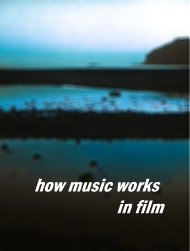
| FAQs (4) about film music |
8.
How music works in film. Twenty one functions of music with examples
1. Creation of physical atmosphere (time of day, climate) - Mandel's "The Sandpiper". Scenes at Big Sur an inutation of natural sounds - crashing of water reproduced in orchestral terms; solo flute evoking the sound of open spaces.
2. Creation of mood - Raksin's "Laura". 3. Evocation of time period -Goldsmith's "Planet of the Apes". Opening scene with Heston in spacecraft: one repeated stopped note in low register of piano, and gradually increasing dynamic volume as pattern is telescoped by slide whistle, emitting an unearthly ghssando sigh gives effect of pulling the spectator into a different time and place with only a few bars of music. 4. Evocation of culture in which the story takes place - Rosenmann's "A Man Called Horse"~ use of eagle boned flutes, recorders, drums, rattles and traditional styles of authentic North American music.
5. Evocation of physical setting (sea, mountain, open spaces)
- Korngold's "Captain Blood" Music for scenes on open sea:
large orchestra, with Wagnerian sweep suggesting the vast
6 Underlining action - North's "Spartacus" Gladiators training the music is discordantly aggressive, full of violence and abrasiveness and uses short rhythmic figures that start, proŚ ceed, then back up and proceed again, in a gradually lengthening pattern to underline the action taking place on screen.
7. Mickeymousing - the music mimics or accents what is
happening on screen. Steiner's "King Kong" on Empire State Building
music rising and falling dramatically in step wise melodic fashion
as Kong climbs. This is a particularly effec 8. Rounding off the film - Mancini's "Days of Wine and Roses ' reprise of melody underscores action of main characters throughout the film. In the final scene where the characters do not reconcile their relationship, the dialogue is underscored with a melody that never concludes, producing a sense of uneasy suspension. 9. Underlining unspoken thoughts of a character - Arnold's "Chalk Garden". The scene where Deborah Kerr meets the judge who sentenced her for murder years before, the music contains a nervous fluttering melody with essentially slow pulsing drum beats, underlining Kerr's agitation about being discovered and simultaneous silent reminders to herself that she can escape it if she keeps control. 10. Revealing unseen implications of a situation - Bazelon's score for a short film by Robert Goodrich, in which a man is seen walking through the streets of New York city. The man is in fact on his way to commit suicide. The score indicates this by blocking out out all the street noises and suggesting to the audience that something is amiss by scoring a long plaintive melody in flugelhorn. 11. Revealing psychological makeup of character -. Mancini's "Wait Until Dark" When Alan Arkin enters Audrey Hepburn's flat, the score reveals Arkin to be mentally disturbed by playing isolated notes on out of tune pianos. 12. Building continuity from scene to scene . - In the scores of the 40s, in many films, music bridges scenes connected by fade ins, fade outs and dissolves. Flashbacks were often 'covered' by vibes glissandi. 13. Building overall continuity - "The Heterosexual". Jean-Louis Trintignant and Stephane Audran make love while Jacqueline Sassard, who has been involved with both, crouches outside the bedroom door. The music develops without a break into an impassioned crescendo as the scene shifts back and forth from inside to outside the bedroom, helping bind the characters together in their menage a trois.
14. Underlining expected reaction of audience - Auric's
"The Innocents" 15. Making philosophical point. In Eisler's "Hangmen also Die". As Heydrich the hangman, lies dying, Eisler uses high strident strings to suggest the death of a rat and not a hero.
16. Setting up an audience for subsequent surprise. Hermann's
"Psycho"
17. Deceiving the audience as to what has actually happened
- Williams'
18. Identifying characters by a theme or musical idea (Leitmotif)
. Jarre's 19. Evoking a character or thing, not actually present on screen. - Rodney-Bennett's "Murder on the Orient Express" The scene where the people gathered on the train enact the murder, xylophone glissando suggests blood splattering when none is seen on screen. 20. As neutral background filler in support of dialogue or especially lengthy narration or in the montage. 21. Source or actual music that which is actually occurring within the film itself. |
| next |
 sea and motion of the waves.
sea and motion of the waves.